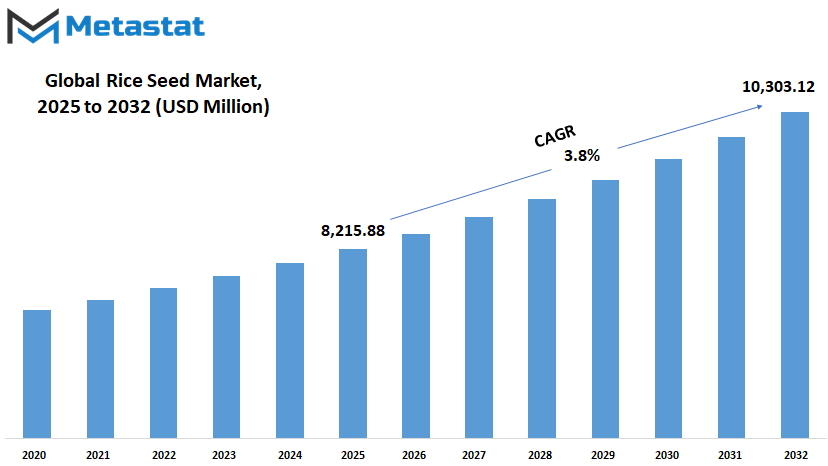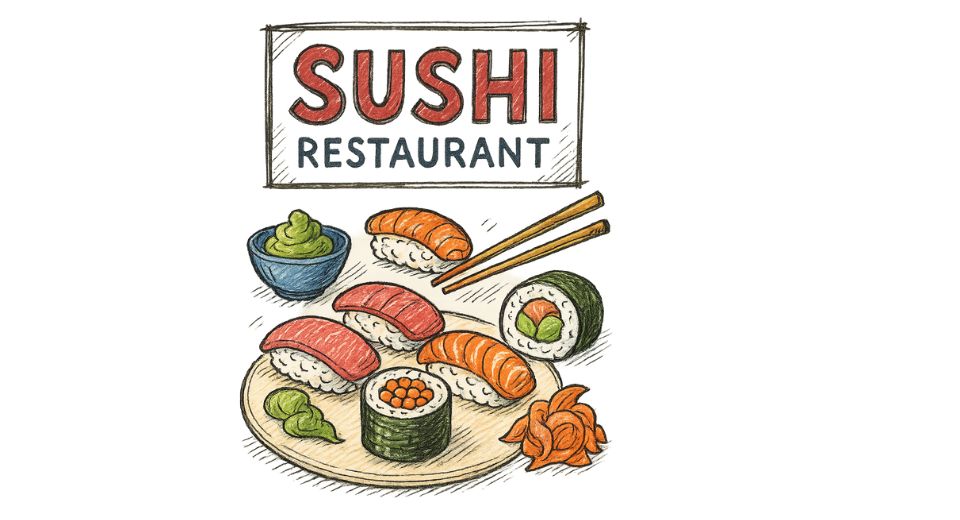MARKET OVERVIEW
The Global Rice Seed market represents a cornerstone of agricultural production directly affecting food security and the supply chain of one of the most widely consumed staple foods. The industry focuses on the development, production, and distribution of seeds cultivated specifically for rice farming. It plays a crucial role in addressing the needs of growing populations, adapting to climatic changes, and responding to shifting agricultural demands. The market greatly influences most economies around the world, which have rice as a staple, especially in major agricultural products that are consumed to satisfy the most basic needs.
The Global Rice Seed market offers a wide-ranging scope of seed type, including hybrids, open pollinated, genetically modified, amongst others. Different seeds are provided for various kinds of farming, environmental conditions and consumer preferences. Hybrid seeds, for example, are developed to improve yield potential and pest resistance. Genetically modified options are created to address issues such as drought or salinity. The market is a global market that reaches across continents, both to the biggest rice-producing nations and to smaller agricultural economies, with each region needing specific seed solutions to meet its unique agronomic and environmental conditions.
This market will further align with technology upgrades because, with the agricultural industry undergoing modernization, innovation shall emphasize improved crop performance. New seed varieties shall be developed through research and development, bringing in superior traits-superior resistance to diseases, shorter growth cycles, higher nutritional value, etc. Precision farming practices influence seed production and distribution, ensuring efficient varieties are supplied to farmers for their specific soil, water availability, and climatic conditions. Digital tools will also transform seed marketing and distribution channels, allowing seamless interaction between producers and end-users.
With countries working towards food security and sustainable farming, the significance of the Global Rice Seed market will continue to increase. There will be closer collaboration between governments, NGOs, and private sectors to create innovations and facilitate access to high-quality seeds in underdeveloped or marginalized regions. Such a collaboration will, in all likelihood, encourage fair growth within the industry, enabling more farmers to benefit from seed technology advancements.
Moreover, the Global Rice Seed market will expand its focus on sustainability. There will be an effort in reducing environmental impact, making seed varieties that require less chemical input and less water cultivated in greener agricultural practices. The efforts towards breeding traditional varieties with modern hybrid will keep a balanced approach toward making progress.
The Global Rice Seed market represents the very backbone in the agricultural space, carrying serious implications on and off global scales, including significant determinants about food systems across the globe’s economies. Ranging from ever-changing dynamics between activities, innovativeness and the diversity in stakeholders’ quest for enhanced production of rice as a staple and cash crop everywhere in the globe, this agricultural market is undergoing evolution and progress with regard to its application today and the trends in future due to challenges expected in the latter.
Global Rice Seed market is estimated to reach $10,303.12 Million by 2032; growing at a CAGR of 3.8% from 2025 to 2032.

GROWTH FACTORS
The Global Rice Seed market is expected to grow significantly with a number of elements shaping its future landscape. Rice is, after all, a staple food for billions of people around the world and continues to find favor on the tables in Asia, Africa, and parts of Latin America. Such widespread consumption demonstrates the significance of rice in addressing food security issues. Notably, with the increase in the global population, it is essential to sustain and efficiently produce rice, thereby boosting this market with high demand advanced varieties of rice seed.
Hybrid or genetically modified (GM) rice seeds are some of the key factors for this market development. These new seeds help benefit more advantages such as high yield levels, tolerance to pests, diseases, and environmental stresses. All these advantages are translated into increased productivity and profitability for farmers, which is the way to meet the increasing demand for rice in the domestic and international markets. Adaptability of GM and hybrid seeds to various climatic conditions enhances their appeal even further, and they are now an essential component in modern agricultural practices.
However, the market still faces challenges that might limit its growth. The regulation of genetically modified seeds is quite strict in most regions, thus reflecting the apprehension of negative impacts on the environment and health. Moreover, the risk of diseases and pests continues to be a threat to rice crops, which may deter some farmers from adopting new seed technologies. This is a reminder that innovation and collaboration among stakeholders are still required to address such issues effectively.
Even with these challenges, the future of the Global Rice Seed market looks bright. The promising opportunity is going to be on the expansion side of rice production in emerging markets. Regions holding untapped potential in agriculture start to realize more economic and social benefits from developing rice production in the region. Investments in infrastructures, technology, and education in improving agriculture practices in those regions will give further impetus to the market.
In the near future, it will be biotechnology and agricultural research that determines the course of the market. More resilient and sustainable rice seed varieties could easily turn the industry upside down and assure food for millions while lowering the environmental footprint. As the world intensifies efforts to optimize agricultural productivity, the Global Rice Seed market is aptly positioned to become a cornerstone of modern food systems, confronting the challenges and opportunities of a rapidly changing world.
MARKET SEGMENTATION
By Seed Types
Over the last few years, growth in the rice seed market across the world has been nothing less than spectacular and has been brought about by multiple factors including growth in the demand for rice, advancement in agricultural technology, and the increased pressure to feed an expanding world population. For the foreseeable future, the Market for rice seeds will continue to expand significantly with multiple critical developments over the next several years. The most dramatic trend is the further diversification of rice seed types, which will power the future of rice cultivation worldwide.
There are three primary types of rice seeds, including conventional, hybrid seeds, and genetically modified (GM) seeds. These types bring different benefits to rice production growth but are engaged in one way or another in growing rice. Conventional seeds have traditionally been the choice for the farmer, at low cost and with a more natural form of cultivation, but hybrid seeds are becoming increasingly used due to higher yield and resistance to pests and diseases. GM seeds are a highly future-scientific approach in rice cultivation – advanced traits such as drought tolerance, nutritional value, and resistance to the diseases.
In 2024, the market for conventional rice seeds is likely to be valued at approximately USD 3,449.17 million, the market for hybrid rice seeds is likely to be valued at about USD 3,452.17 million, and the market for GM rice seeds is likely to be valued at about USD 1,031.18 million. Hybrid and conventional rice seeds will be dominant, but genetically modified seeds will also pick up as the farmer seeks solutions to the challenge of climate change and increasing population demands.
Looking ahead, the demand will surely increase due to the pursuit of hybrid as well as genetically modified rice seed, as an alternative means toward higher yields in sustainable agriculture systems. As that market grows on, technology becomes a tool for developing newer varieties of the rice seed that does not only withstanding the impacts of changing environmental situations but also would meet the food and nutritional diversity requirements of target populations. The factors driving the growth of the global rice seed market will be related to better seed varieties, improving rice production.
As climate change continues to impact agriculture around the world, the future of rice cultivation will heavily depend on hybrid and GM seeds, offering higher efficiency in the face of unpredictable weather patterns. The global rice seed market will continue to evolve with these shifts, positioning itself as a key player in securing food supply for the future. In conclusion, the global rice seed market will remain a dynamic and essential component of the agricultural industry as it adapts to meet the needs of the next generation of farmers and consumers.
By Origin of Germplasm
In all, the worldwide market for rice seed plays the most fundamental part in the rice production of tomorrow. Rice constitutes one of the staple foods available today for an overwhelming majority around the world to consume. Of course, growing demand for good varieties of rice that can show improved yield together with resistance in diseases and easy adaptability due to changing climatic conditions adds to the picture. In the near future, large-scale innovations along with shifting market dynamics will be seen in the rice seed market. Germplasm used in rice seeds needs to be understood as to where it came from in order to tackle such issues. Market can be bifurcated mainly into two heads: native germplasm and exotic germplasm.
Native germplasm is often described as seeds that are produced from native and grown rice varieties in particular regions. Over time, these environments have naturally adapted them and best fit the local conditions. Native germplasm will receive greater value around the world with increased adoption of sustainable farming techniques among farms. Such seeds have their native counterparts, who use fewer inputs and are harder to the pests and diseases local to their ecosystem. The rice varieties that farmers will likely demand in the near future are those natives, which require less meddling with chemicals in the form of fertilizers or chemical treatments. The concern regarding environmental impact as people increasingly wake up to traditional agriculture and high dependency on chemical inputs will not be far behind.
Exotic germplasm refers to rice seeds imported from other regions or countries. Such varieties might have some particular traits that would make them interesting for commercial production, such as a higher yield, better resistance to pests, or improved grain quality. Exotic germplasm will remain important in the international rice seed market, particularly in regions where local varieties are not able to satisfy the increased demand for rice. More likely than not, it will open further avenues to more exotic germplasm once hybrid rice varieties of both local and exotic backgrounds start to come on the boards to be considered. These should give better protection from changing climatic conditions, thereby being a benefit to the resource use, so both farmer and consumer may find them very acceptable.
Advancing technologies will surely unlock new global rice seed opportunities by alteration and improvement in rice germplasm. Biotechnological advancement has been a route further to strengthen the traits found in native versus exotic varieties by scientists. Further development of adaptive rice seeds has been made viable by enhancing seed productivity. In the long term, it is likely that varieties will increasingly help ensure food security and support sustainable agricultural practices in the world.
By Varieties
The Global Rice Seed market is critical in the production of rice, one of the most important food crops globally. Rice is a staple for most people in the world and demand for all kinds of rice continues to rise. Climate change, technological advancement, and change of consumer preference will define this future market. These factors will determine how the rice seed types will influence rice production. With the increase in population, the importance of sustainable agricultural practices is going to gain prominence and drive new innovations in rice seed varieties and farming techniques.
The market for rice seeds can be divided into various categories based on the grain variety, catering to different consumer preferences and regional needs. Long-grain varieties are commonly grown in regions with a high demand for rice that cooks dry and separate, such as many parts of Asia and the Middle East. The grains are known for their fluffy texture when cooked, making them ideal for many traditional dishes. In the years ahead, with increasing demand for convenient, easy-to-cook, and health-conscious food, long-grain rice varieties will continue to increase in popularity in convenience markets.
Medium-grain varieties, found throughout the Mediterranean and parts of the United States, are a little sticky when cooked, and their best use is in dishes such as risotto and paella. Such varieties are likely to gain popularity further with the growth in ethnic food consumption and greater demand for a diversified food variety in international markets. With time, changing consumer preferences will be complemented with medium-grain rice as people find it an ideal choice due to its variety in cooking applications and its suitability to absorb the flavors of food served in a dish.
Short-grain varieties, known for their sticky and moist texture, are commonly used in Asian cuisine for dishes like sushi and sticky rice. In the future, short-grain rice will remain popular, especially in countries where these dishes are staples. Furthermore, as global trade and travel bring more exposure to international food cultures, short-grain varieties will likely continue to expand in popularity in markets outside of Asia. Improved pest resistance and higher yield per acre through innovations in seed technology will also drive growth in short-grain rice cultivation.
Overall, the future for the Global Rice Seed market will be bright because of the developments in seed research and the increasing need for rice consumption in different types. As this market expands and diversifies, all varieties of rice—long-grain, medium-grain, and short-grain—will play a role in feeding an ever-growing population and meeting new demands from the consumer.
By Characteristics
The Global Rice Seed market is one of the most important segments of the agricultural industry, which has immense growth and innovation potential. There are several factors over the next few years by which demand for rice seeds will be driven, like a change in consumers’ preferences, advances in agricultural technologies, and growing demand for food produced sustainably. With rice still being one of the most consumed staple foods around the globe, the market will continue to change, driven by both regional differences and global trends.
One characteristic that will define the global Rice Seed market is that of variety in its rice types. It has characteristics differentiated not only geographically but in properties such as aroma, length of the grain, texture, and even its cookability. The fragrance is a big influencer on consumers in different regions, varying from light, fragrant rice to more neutral or subtle smells of rice. Often one of the most demanded qualities, in premium rice, aroma contributes greatly to the culinary experience.
Grain length will remain an important influencer in the market. Rice seeds come in three main grain lengths—long, medium, and short. Long-grain rice is typically fluffier and separate grain; it is often used in dishes where individual grains are desired, such as pilafs or fried rice. Medium-grain rice is used in various types of cuisines for different dishes like risottos or casseroles. Short-grain rice is very sticky and clumpy; therefore, this type of rice is well suited for sushi or other dishes where the rice is cooked to stick together.
Texture also plays an important role in the perception of rice by the consumer. Rice may be either fluffy or sticky, depending upon the type of rice and its method of preparation. The preference in texture varies geographically, and the global Rice Seed market will also experience a high demand for the rice varieties which can cater to the varied preferences.
Cook qualities are equally pertinent. Absorption as well as shape retention characteristics determine rice behavior when it is cooked, hence impacting its usefulness for different cuisines. Rice which tastes better because flavors are absorbed onto it or retains its shape after cooking, has a lot of demand. That is so because cooking impacts the quality of food prepared directly. All these traits are expected to increase the production of rice seed varieties for special cookery uses.
The Rice Seed market will also be segmented geographically based on rice subspecies. There are two forms mainly that lead in the market, namely: Oryza sativa subsp. Indica (Indica rice), and on the other hand, *Oryza sativa subsp. Japonica* (Japonica rice). Indica rice is the long-grain non-sticky type of rice, grown in the tropical and subtropical region. Japonica is shorter, stickier, and also used where clumpy is desired in the cooked dish. All of these sub-species will drive consumer demand in the years ahead and each has a unique set of cooking attributes and flavor characteristics.
Future innovations in the global Rice Seed market will be established based on changing demands of both consumers and producers. For example, agro-science and technology will further boost high-yielding varieties with improved cooking properties and increased resistance to disease. Climate change and sustainability issues will also drive research into rice seed varieties that will adapt to changed environmental conditions and offer a stable and consistent supply of rice for an ever-growing population.
|
Forecast Period |
2025-2032 |
|
Market Size in 2025 |
$8,215.88 million |
|
Market Size by 2032 |
$10,303.12 Million |
|
Growth Rate from 2024 to 2031 |
3.8% |
|
Base Year |
2024 |
|
Regions Covered |
North America, Europe, Asia-Pacific, South America, Middle East & Africa |
REGIONAL ANALYSIS
It is one of the most integral parts of agriculture across the globe, used to maintain food security across a burgeoning global populace. Geographical factors have a comprehensive impact on the market, causing regional variations in its growth, challenges, and opportunities. The different regions segmenting the global rice seed market include North America, Europe, Asia-Pacific, South America, and the Middle East & Africa.
North America, in which the United States, Canada, and Mexico play significant roles, has led the adoption of advanced agricultural technologies. The region is the leading producer of high-yield and hybrid seed. Its farmers have targeted increased productivity to satisfy domestic consumption and export demand. Research and development in North America have led to the continuous introduction of new rice seed varieties that are resistant to pests and diseases, thus providing long-term sustainability in production.
Europe also possesses its own challenges and benefits it brings into play. In the market-driven countries, these include the UK, Germany, France, and Italy, there have been developments seen in agriculture systems and stringent standards of quality to be followed by the manufacturers of rice. Since rice is less of a grown crop in European regions as a whole, most of it comes from the specified portions of Europe itself. These countries focus on seed development that is adapted to the local climatic conditions, which allows them to cope with the environmental changes.
Asia-Pacific, including India, China, Japan, South Korea, and others, leads the world in rice seed market. The region is the largest producer and consumer of rice and thus plays a significant role in global trends. The growing population and increasing demand for rice have compelled countries here to focus on hybrid varieties and genetically enhanced seeds. China and India, being major players, are investing heavily in research to improve yields and challenge issues such as water scarcity and soil degradation. The region is expected to influence the future of rice cultivation in the world.
Rice farming is slowly but surely advancing in South America, with Brazil and Argentina leading the way. Modern cultivation techniques are being adopted by farmers, and seed quality is being improved to enhance production. The fertile lands of the region give it an advantage, and the continued push for export growth underlines the growing importance of this market.
In the Middle East & Africa region, things are also changing, with GCC countries, Egypt, and South Africa growing rice. With the development of seeds suitable for arid conditions and limited water supply, this region can ensure sustainability in its production while serving the local and regional markets.
Overall, the Global Rice Seed market reflects diverse regional contributions, which are shaping the future trajectory of innovation, adaptation, and commitment towards meeting the emerging needs of the global agriculture system.

COMPETITIVE PLAYERS
The global rice seed market is, therefore, of great importance as its growth fuels food security worldwide. Rice forms a staple of the diet of a large fraction of the earth's population; hence, demand for superior quality seeds guaranteeing higher productivity and resistance against environmental adversities continues to boost the market for rice seeds. The world has increasingly faced numerous challenges from climate change, increased population, and arable land, making the need for innovation in the rice seed industry quite important. In the competitive scene, Bayer AG, Syngenta, Corteva Agriscience, Advanta Seeds, and other companies are working day and night to develop more resilient, productive, and adaptive seeds for a wide range of farming environments.
Other major players in the market include Nuziveedu Seeds, Rasi Seeds, BASF, SL Agritech, Guard Agri, and National Seeds Corporation, all of which focus on regional and global needs. Limagrain, RiceTec, Inc., and Mahyco Seeds Limited further strengthen this competitive landscape by working to create solutions tailored to the unique challenges of rice production. The future of the global rice seed market is promising, with the potential for major breakthroughs based on technological advancement and investment in research and development.
Genetic modification, precision agriculture, and bioengineering are likely to redefine the way rice is grown. For example, seeds engineered to thrive under harsh climatic conditions or resist specific pests and diseases will likely become more prevalent. Such innovations not only increase yields but also reduce dependence on chemical inputs, which is in line with the global push toward sustainable agriculture. Besides this, there is a rising consciousness of environmental consequences of the usual farming approach in the direction of sustainable seed production. In light of these changing times, opportunities are emerging in the marketplace to lead through ecologically friendly agricultural solutions.
This improvement in quality and availability will occur due to increasing collaborations between public and private sectors as governments and organizations provide incentives for projects meant to advance food security and sustainability. The global rice seed market, therefore, is not only an important part of today's agricultural system but also the focus for tomorrow's farming. With competitive players driving innovation and sustainability, the industry is well placed to be at the heart of the challenges facing the world and to ensure that the demand for rice can be met efficiently in the years to come.
Rice Seed Market Key Segments:
By Seed Types
- Conventional Seeds
- Hybrid Seeds
- Genetically Modified (GM) Seeds
By Origin of Germplasm
- Native Germplasm
- Exotic Germplasm
By Varieties
- Long-Grain Varieties
- Medium-Grain Varieties
- Short-Grain Varieties
By Characteristics of Varieties
- Aroma
- Grain Length (Long, Medium, Short)
- Texture (Fluffy, Sticky)
- Cooking Properties (Absorption, Retention of Shape)
- Subspecies
- Oryza sativa subsp. indica (Indica Rice)
- Oryza sativa subsp. japonica (Japonica Rice)
Key Global Rice Seed Industry Players
- Bayer AG
- Syngenta
- Corteva Agriscience
- Advanta Seeds
- Nuziveedu Seeds
- Rasi seeds
- BASF
- SL Agritech
- Guard Agri
- National Seeds Corporation
- Limagrain
- RiceTec, Inc.
- Mahyco Seeds Limited
WHAT REPORT PROVIDES
- Full in-depth analysis of the parent Industry
- Important changes in market and its dynamics
- Segmentation details of the market
- Former, on-going, and projected market analysis in terms of volume and value
- Assessment of niche industry developments
- Market share analysis
- Key strategies of major players
- Emerging segments and regional growth potential








 US: +1 3023308252
US: +1 3023308252






